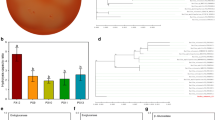Abstract
Several bioprocessing technologies, such as separate hydrolysis and fermentation (SHF), simultaneous saccharification and fermentation (SSF), and consolidated bioprocessing (CBP), have been highlighted to produce bio-based fuels and chemicals from lignocellulosic biomass. Successful CBP, an efficient and economical lignocellulosic biorefinery process compared with other processes, requires microorganisms with sufficient cellulolytic activity and biofuel/chemical-producing ability. Here, we report the complete genome of Paenibacillus sp. CAA11, a newly isolated promising microbial host for CBP-producing ethanol and organic acids from cellulose. The genome of Paenibacillus sp. CAA11 comprises one 4,888,410 bp chromosome with a G + C content of 48.68% containing 4418 protein-coding genes, 102 tRNA genes, and 39 rRNA genes. The functionally active cellulase, encoded by CAA_GH5 was identified to belong to glycosyl hydrolase family 5 (GH5) and consisted of a catalytic domain and a cellulose-binding domain 3 (CBM3). When cellulolytic activity of CAA_GH5 was assayed through Congo red method by measuring the size of halo zone, the recombinant Bacillus subtilis RIK1285 expressing CAA_GH5 showed a comparable cellulolytic activity to B. subtilis RIK1285 expressing Cel5, a previously verified powerful bacterial cellulase. This study demonstrates the potential of Paenibacillus sp. CAA11 as a CBP-enabling microbe for cost-effective biofuels/chemicals production from lignocellulosic biomass.


Similar content being viewed by others
References
Kawaguchi H, Hasunuma T, Ogino C, Kondo A (2016) Bioprocessing of bio-based chemicals produced from lignocellulosic feedstocks. Curr Opin Biotechnol 42:30–39. https://doi.org/10.1016/j.copbio.2016.02.031
Ko JK, Jung JH, Altpeter F, Kannan B, Kim HE, Kim KH, Alper HS, Um Y, Lee S-M (2018) Largely enhanced bioethanol production through the combined use of lignin-modified sugarcane and xylose fermenting yeast strain. Bioresour Technol 256:312–320. https://doi.org/10.1016/j.biortech.2018.01.123
Lee HR, Kazlauskas RJ, Park TH (2017) Mild pretreatment of yellow poplar biomass using sequential dilute acid and enzymatically-generated peracetic acid to enhance cellulase accessibility. Biotechnol Bioprocess Eng 22(4):405–412. https://doi.org/10.1007/s12257-017-0139-7
Okino S, Ikeo M, Ueno Y, Taneda D (2013) Effects of Tween 80 on cellulase stability under agitated conditions. Bioresour Technol 142:535–539. https://doi.org/10.1016/j.biortech.2013.05.078
den Haan R, van Rensburg E, Rose SH, Gorgens JF, van Zyl WH (2015) Progress and challenges in the engineering of non-cellulolytic microorganisms for consolidated bioprocessing. Curr Opin Biotechnol 33:32–38. https://doi.org/10.1016/j.copbio.2014.10.003
Parisutham V, Kim TH, Lee SK (2014) Feasibilities of consolidated bioprocessing microbes: from pretreatment to biofuel production. Bioresour Technol 161:431–440. https://doi.org/10.1016/j.biortech.2014.03.114
Jiang Y, Chen T, Dong W, Zhang M, Zhang W, Wu H, Ma J, Jiang M, Xin F (2018) The draft genome sequence of Clostridium beijerinckii NJP7, a unique bacterium capable of producing isopropanol–butanol from hemicellulose through consolidated bioprocessing. Curr Microbiol 75(3):305–308. https://doi.org/10.1007/s00284-017-1380-1
Singh N, Mathur AS, Gupta RP, Barrow CJ, Tuli D, Puri M (2018) Enhanced cellulosic ethanol production via consolidated bioprocessing by Clostridium thermocellum ATCC 31924☆. Bioresour Technol 250:860–867. https://doi.org/10.1016/j.biortech.2017.11.048
Lin PP, Mi L, Morioka AH, Yoshino KM, Konishi S, Xu SC, Papanek BA, Riley LA, Guss AM, Liao JC (2015) Consolidated bioprocessing of cellulose to isobutanol using Clostridium thermocellum. Metab Eng 31:44–52. https://doi.org/10.1016/j.ymben.2015.07.001
la Grange DC, den Haan R, van Zyl WH (2010) Engineering cellulolytic ability into bioprocessing organisms. Appl Microbiol Biotechnol 87(4):1195–1208. https://doi.org/10.1007/s00253-010-2660-x
Kim ES, Kim BS, Kim KY, Woo HM, Lee SM, Um Y (2018) Aerobic and anaerobic cellulose utilization by Paenibacillus sp. CAA11 and enhancement of its cellulolytic ability by expressing a heterologous endoglucanase. J Biotechnol 268:21–27. https://doi.org/10.1016/j.jbiotec.2018.01.007
Teather RM, Wood PJ (1982) Use of Congo red-polysaccharide interactions in enumeration and characterization of cellulolytic bacteria from the bovine rumen. Appl Environ Microbiol 43(4):777–780
Ventorino V, Aliberti A, Faraco V, Robertiello A, Giacobbe S, Ercolini D, Amore A, Fagnano M, Pepe O (2015) Exploring the microbiota dynamics related to vegetable biomasses degradation and study of lignocellulose-degrading bacteria for industrial biotechnological application. Sci Rep 5:8161. https://doi.org/10.1038/srep08161
Tatusov RL, Galperin MY, Natale DA, Koonin EV (2000) The COG database: a tool for genome-scale analysis of protein functions and evolution. Nucleic Acids Res 28(1):33–36
Zhang XZ, Sathitsuksanoh N, Zhu Z, Percival Zhang YH (2011) One-step production of lactate from cellulose as the sole carbon source without any other organic nutrient by recombinant cellulolytic Bacillus subtilis. Metab Eng 13(4):364–372. https://doi.org/10.1016/j.ymben.2011.04.003
Acknowledgements
This research was supported by C1 Gas Refinery Program through the National Research Foundation of Korea (NRF) funded by the Ministry of Science, ICT (Information & Communication Technology) & Future Planning (2016M3D3A1A01913249). The authors also appreciate further support by Korea Institute of Science and Technology (KIST) Institutional Program (2E28290).
Author information
Authors and Affiliations
Corresponding author
Ethics declarations
Conflict of interest
The authors declare no conflict of interest.
Additional information
Publisher's Note
Springer Nature remains neutral with regard to jurisdictional claims in published maps and institutional affiliations.
Rights and permissions
About this article
Cite this article
Gong, G., Oh, H.J., Cho, S. et al. Complete Genome Sequence of Paenibacillus sp. CAA11: A Promising Microbial Host for Lignocellulosic Biorefinery with Consolidated Processing. Curr Microbiol 76, 732–737 (2019). https://doi.org/10.1007/s00284-019-01685-w
Received:
Accepted:
Published:
Issue Date:
DOI: https://doi.org/10.1007/s00284-019-01685-w




